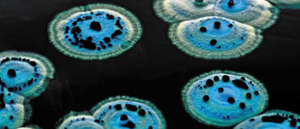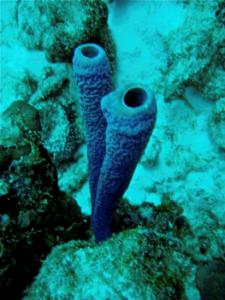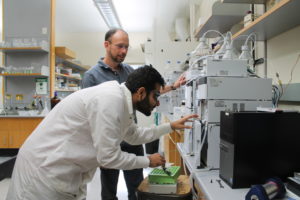The need for new antibiotics fuels Professor Tim Bugni’s push to find novel molecules in marine bacteria
By Jill Sakai
Tim Bugni was biding his time, a few years into a stint managing his former doctoral advisor’s lab at the University of Utah, waiting for the perfect moment to take the next step in his career. That’s when he heard about an intriguing opening at the University of Wisconsin–Madison School of Pharmacy. The position sounded like a great fit for his expertise in the chemistry of natural products, which are small, biologically active molecules sourced from nature. The timing, though, was less ideal.
“I was just getting ready to go on a research expedition to Vanuatu in Oceania,” Bugni recalls. But the job was too good to pass up. He squeezed in his application prep in early mornings and around collection forays. He made the deadline—and the cut.
“It was the only job I applied for,” he says. “I was patiently waiting for the right opportunity, and I found it at UW–Madison.”
Less than 10 years after joining the School, he has helped establish a National Institutes of Health-funded research center on campus, co-founded a start-up company, submitted multiple patents on promising new agents and revitalized the School of Pharmacy’s focus on natural products as a source for drug discovery, which led to the discovery of a new antibiotic, keyicin. This fall, he was promoted to professor in the School’s Pharmaceutical Sciences Division and was selected for the 2018 Waters’ Award for Excellence in Natural Products Innovation.
“There’s an immense diversity out there, waiting to be discovered.”
–Tim Bugni
Bugni’s overall goal is to find novel small molecules with the potential to fight cancer or infectious disease. His string of successes is a testament to his dedication to discovery.
“Most of our antibiotics have come from bacteria from the soil,” he explains. But after several bursts of discoveries mid-last century, terrestrial sources have stopped yielding promising candidates. Now his research group is tapping into a new source: the richness of the sea.
A ‘natural’ fit
Bugni didn’t start out with grand designs to reshape the world of drug discovery. From an initial plan to become a chemical engineer, he “sort of stumbled” into the field of natural products as an undergraduate at Montana Tech. That was enough to get him hooked.

Since then, his focus hasn’t wavered. During his graduate studies and postdoctoral appointment, he deepened his expertise in molecular isolation and analytical chemistry. He traveled the world’s oceans seeking novel compounds and bacterial strains associated with a variety of marine animals, fungi and algae.
He came to the UW–Madison School of Pharmacy excited to help create a center for natural products research. But a few faculty departures shortly after his arrival left the future of the program and his research uncertain. “Making the decision to continue to build the program without those colleagues and collaborators was one of the most difficult decisions,” Bugni says. “But the evidence of that being the right decision is here right now.”
The department now houses a vibrant team of researchers who work on natural products and drug discovery, including Assistant Professor Jason Kwan, who is searching ancient “living rocks” from the coast of South Africa for therapeutic potential.
Bugni has also established a web of fruitful connections beyond the School of Pharmacy. A collaboration with David Andes in the UW Department of Medicine and Cameron Currie in the UW Department of Bacteriology brought to UW–Madison an NIH-funded Center of Excellence for Translational Research, one of 14 CETRs around the country established to speed the process of getting basic research into the clinic. Bugni, Andes, Currie and others also started a company, Symbiotica, to extend the impacts of their work and help their products reach the market.
“Dr. Bugni exhibits a combination of an extremely valuable and unique talent in drug discovery and development along with a passion for impact translation of his efforts to both patients and advancing science,” says Andes.
Such efforts are crucial, Bugni says, to fill the gaps left by shifting priorities in the pharmaceutical industry.
Finding new well of possibility
The pipeline of new antibiotics has been waning for decades, as repeated searches in the same kinds of environments—soil, mainly—failed to yield new discoveries. Then advances in genomics early this century led to a resurgence of interest. Full genomic sequencing of major bacterial strains revealed genetic code for a myriad of unknown compounds. Faced with a slew of new potential molecules, companies rushed to try to unlock the hidden secrets of these silent genes.
The major pharmaceutical companies undertook massive searches, screening tens of thousands of compounds against dozens of targets of clinical interest, at enormous effort and cost.

“What came out of it,” Bugni says, “was nothing.”
Since then, big pharmaceutical companies have all but abandoned research into new antibiotics. That leaves a shrinking pool of treatment options and a growing clinical need, especially with the spread of bacterial resistance against existing drugs.
Bugni says the push to find new avenues of drug discovery creates “a nice opportunity to get back to the roots of where antibiotics came from”—that is, nature. Historically, natural products harken back to a time when the field of medicine was rooted in knowledge about the natural world.
So he has turned to a largely untapped natural environment: the ocean. Marine invertebrates, such as the sponges he studies, host an astoundingly diverse microbial population, Bugni says. Those microbes in turn produce a massive number and quantity of small molecules. It’s likely that at least some of them have useful antibiotic activity—but those potential gems are mixed in with a slew of common and irrelevant molecules.
“The question is, how do you sort through that in an effective manner and get to the molecules of interest?” he says. Using advanced metabolomics techniques, he is tackling the challenge as a statistics problem: find the outliers, the molecules that are most unlike the others. Those have the best chance of being something truly novel.
“That’s really the area that my research focuses on,” he says. “We develop and test analytical strategies to find the new molecules, with the idea that many of these are potential antibiotics.”
Improving the odds of discovery
In some ways, his search for unusual molecules parallels the overall process of research. “I think 90 percent of research just purely doesn’t work,” he says. “But that 90 percent of your time is solving problems to get you to the 10 percent that yields promise.”
Fortunately, he says, he enjoys problem-solving. And as in his research, he’s finding ways to improve the odds.

As he tells his students, part of research is determination and discipline, “being able to show up every day regardless of what your results are.” Another part is focusing on the process and learning to identify meaningful outcomes. For example, he finds great meaning in helping to launch other peoples’ careers.
And finally, he tells young researchers that it helps to not get caught up in a narrow view of the original plan. “You have to be flexible and ready to switch gears if needed,” he says. An unexpected result could be the death of a hypothesis—or it could herald an intriguing new path. “I think if you’re trying to do something new, then you’re inevitably going to encounter things that you couldn’t have thought about,” he says.
Such pragmatism has been “invaluable to our team,” Andes says. “His willingness to both troubleshoot study bottlenecks and frankly state when he feels the bottleneck is too large is critical for optimal stewardship of time and fiscal resources. He is almost always right.”
Bugni’s approach is paying off.
“It’s predicted that if you go out into the soil here, you need to sample 100,000 to 1 million bacterial strains to find one new molecule—not one new antibiotic, but one new molecule,” Bugni says. “With the new analytical techniques we’ve developed, we can look at several hundred strains to find multiple new molecules.”
After examining fewer than 1,000 bacterial strains to date, his team has already found nearly 100 new molecules of interest. Recently, they improved their computing capability to be able to start sifting through even larger batches, and Bugni is excited to see what they will be able to find.
“Dr. Bugni exhibits a combination of an extremely valuable and unique talent in drug discovery and development along with a passion for impact translation of his efforts to both patients and advancing science.”
–David Andes
Another way he and his collaborators are increasing their chances of discovery is by recreating bacterial interactions typically found in nature that can awaken otherwise dormant antibiotic capacities. This process, called co-culturing, has led the team to file three patents for potential new drugs—two related to infections, and one in the area of cancer—in the summer of 2018.
Twenty years ago, when antibiotic-discovery efforts began turning up the same compounds again and again, many pharmaceutical companies decided that meant they had found all there was to find.
Bugni won’t make that same mistake. He points to the genomics work as evidence that researchers have barely scratched the surface of nature’s potential. “There’s an immense diversity out there, waiting to be discovered,” he says.
Learn more about the research in the Bugni Lab, his career at the School of Pharmacy, and the recent discovery of keyicin.
Read about the natural products discovery in Assistant Professor Jason Kwan’s lab.